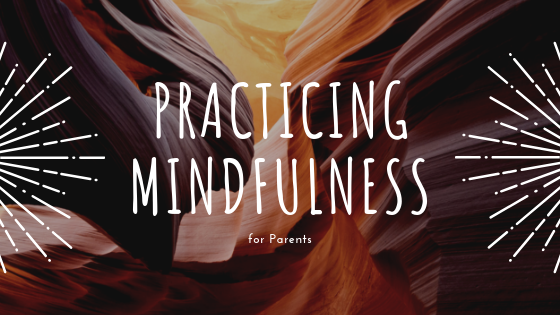
Practicing Mindfulness Helps Combat Parenting Stress
"Hurry up! Get your shoes on!"
"We don't have time to play right now."
"Why didn't you go to the bathroom before we left?!"
"What do you mean you forgot you had homework??"
"Do NOT hit your sister!"
"This is why we put lids on our cups!"
Do any of those lines sound familiar to you? Raising children can test patience and emotional control. Many parents feel overwhelmed and out of control when dealing with the small humans we are charged to care for. Often, we wish we could feel differently but aren't sure how to change our thoughts or actions.
One way to address these feelings is to take a moment to practice mindfulness. You may have heard of mindfulness recently and wondered what it is or why it seems so popular right now. The main idea behind mindfulness is to take a few moments to reengage with your conscious awareness by focusing on the present moment without judgment or expectation. This is often encouraged through breathing exercises, meditation, or other forms of focused relaxation.
Why Practice Mindfulness?
Research into the effects of mindfulness have shown wonderfully positive outcomes for those who practice:
- Boosts immune system's ability to fight illness
- Increases positive emotions and decreases negative emotions
- Helps us ignore distractions or refocus on a task
- Improves memory and overall attention
- Increases relationship satisfaction
- Reduces anxiety and stress
Parents who practice mindfulness report greater satisfaction with their parenting skills, improved relationships with their children, and their children have better social skills. Children who are taught to practice mindfulness show less aggression, improved attention, greater ability to calm down when stressed or upset, and improve overall emotion regulation.
This short video from the Mind Body Project explains the ideas behind mindfulness:
How Can I Practice Mindfulness?
The benefits of practicing mindfulness are clear, so how and when should we use it?
There are many ways to practice mindfulness, but the simplest one involves focusing on your breathing. This practice involves purposeful focus on your breathing. By focusing on your breathing, you can regain control of negative emotions, increase focused awareness on the present, and lower your heart rate. This activity can be practiced at any time you feel the need to refocus your awareness or improve your mental state.
Sit or lie down in a comfortable position. Relax your body. Close your eyes. Focus on your breathing. Feel the breath going in and out. Over and over. One way to maintain focus is to count your breaths. When you first begin, try counting 10 breaths. As you become more practiced, increase the time you spend in a mindful state. Setting a short timer for 2 to 5 minutes may be a good starting place.
This video offers an introduction into mindful breathing:
Mindfulness meditation may also be useful in moments of high stress. If you feel a negative emotion such as anger or anxiety, a way to bring that emotion into check is to take a quick moment to breath deeply and exhale completely. Try this a few times and then reengage in the situation calmly if need be. For example, using this technique in an intense moment with a child may keep you from yelling or engaging in an argument that doesn't need to happen. It may help you stay calm in a traffic jam or with a difficult co-worker.
It is never too early or too late to begin using these techniques. Introducing them to young children may cut down on negative emotions and increase overall emotion regulation. Children who show a strong ability to regulate their emotions have significantly more positive outcomes in life such as more and stronger friendships. Teaching a child to focus on her/his breathing can also help in reducing tantrum behavior, calm down when they are very upset, and relax when they are stressed. This practice may also be useful when winding down for sleep. There are many ways to introduce mindfulness to children such as focused breathing, introducing a "breathing buddy," prompting your child to focus on a specific sensory experience such as what they hear at that moment, or making them a glitter bottle or using a snow globe to offer a place to focus.
In general, practicing mindfulness has no downside. Focusing awareness on the present moment to insure that you are actively engaging in your life and your surroundings offers myriad benefits for little investment. One thing to remember: Give yourself time. Don't assume this will come easily to you. It does take practice and it is not something from which everyone finds immediate benefit. Don't allow it to add stress to your life. Try your best, and it will become easier over time. Even if you only ever use mindfulness in times of high stress, you will feel calmer and in better control in those situations, and so will your children. Over time, you may even find yourself stopping to look at your surroundings during a time you usually run on auto-pilot. Stop and take a moment to enjoy your life. It goes far too quickly.
For More Information:
- How mindful are you? http://greatergood.berkeley.edu/quizzes/take_quiz/4/
- Kabat-Zinn Mindfulness Research: http://greatergood.berkeley.edu/topic/mindfulness/definition
- Mindfulness for Children: http://annakaharris.com/mindfulness-for-children/
- https://www.psychologytoday.com/blog/compassion-matters/201303/benefits-mindfulness
- http://www.huffingtonpost.com/sarah-rudell-beach-/8-ways-to-teach-mindfulness-to-kids_b_5611721.html